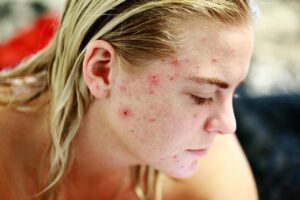Sugar is often thought of as an enemy of good skin health, but did you know that it can also aggravate seborrheic dermatitis? Although the exact cause of seborrheic dermatitis isn’t known, it’s thought to be related to an overproduction of oil in the skin.
Sugar can cause the sebaceous glands to produce more sebum, which can lead to an overgrowth of Malassezia yeast on the skin. Sugar also affects the skin barrier and causes chronic inflammation. While there is a lack of evidence linking high intake of sugar to seborrheic dermatitis, sugar likely has a negative impact on the condition and our health in general.
Let’s take a deep dive:
How does sugar affect seborrheic dermatitis?
Sugar is a term that includes all sweet carbs but is most often used to describe table sugar (sucrose). While sugar is safe in moderation, consuming too much sugar can lead to health problems such as obesity and diabetes.
In recent years, sugar has become a public health enemy. It’s added to so many of the foods we eat, from breakfast cereals to lunchtime salads, and is hidden in many processed foods. Sugar can even be found in some medications, such as cough syrup.
Sugar intake has not been directly linked to seborrheic dermatitis. To be fair, it’s really hard to confirm one way or the other wether something we eat or don’t eat has caused a disease. Plus, there are hardly any studies looking at dietary patterns in seborrheic dermatitis sufferers.
There are really only 2 published studies I could find:
- The Rotterdam Study reviewed the dietary patterns of 4379 participants, of whom 636 had seborrheic dermatitis. The researchers concluded that in females, a high fruit intake was associated with less SD, whereas a ‘Western’ dietary pattern was associated with more SD. No dietary conclusions could be made for males.
- Another small study on 51 patients looked at the dietary habits of SD sufferers and found the frequency of intake of foods was similiar between people with SD and ‘healthy’ people except vegetables. They found vegetable consumption was significantly more common among SD patients than in ‘healthy’ individuals! The researchers concluded that dietary habits were not associated with increased risk of seborrheic dermatitis.
While the only ‘evidence’ we have points to the fact that sugar does not aggravate seborrheic dermatitis, the second study especially was crude, superficial and cannot draw any meaningful conclusions.
We know a healthy, balanced diet is critical to health. Sugar in particular can cause damage to many of our body systems, including those involved in seborrheic dermatitis.
Let’s take a look at how sugar affects some of the factors associated with seborrheic dermatitis:
Effects of sugar on hormones
Sugar can have a profound effect on the endocrine system. It can disrupt hormone levels and cause havoc in virtually every organ.
Cortisol is a hormone that is released in response to stress. It has many functions, including regulating blood sugar levels. Consuming sugar can raise cortisol levels. This can lead to a number of health problems, such as weight gain, type 2 diabetes and high blood pressure. More importantly for SD sufferers, higher cortisol levels lead to higher sebum production, more acne and reduced skin integrity.

You may also be interested in Does stress trigger seborrheic dermatitis?
Effects of sugar on sebum production
Sebum is an oily substance produced by the sebaceous glands. It helps to keep the skin moisturized and protects it from bacteria and other foreign substances.
High sugar intake has been linked to increased sebum production. This is because sugar can trigger a release of insulin, which in turn stimulates the sebaceous glands to produce more sebum. More sebum equates to an oiler face, encouraging Malassezia growth.
Further reading: What foods trigger seborrheic dermatitis?
Effects of sugar on Malassezia
Malassezia is a type of fungus. It’s normal for small amounts of this fungus to live on your skin. But sometimes, Malassezia can grow out of control. When this happens, it can cause skin problems like seborrheic dermatitis.
Sugar and Malassezia: What’s the connection?
Malassezia feeds on skin oils, not sugar. By rights consuming sugar and carbohydrates should not affect Malassezia. However, as we discussed above, sugar causes higher sebum production which provides more food for Malassezia to thrive.
You may also be interested to read Malassezia and seborrheic dermatitis: Getting to know the yeast
How does sugar affect skin integrity?
Sugar can damage the acid mantle, which is the natural barrier that protects our skin from harmful bacteria and environmental toxins. When the skin barrier is damaged, it can lead to dryness, redness, and inflammation. This also allows Malassezia and its byproducts to penetrate deeper into the skin, illiciting more inflammatory reactions.
Sugar can also contribute to skin aging. Sugar molecules can attach to proteins in the body, including collagen and elastin. This process is called glycation. Glycation makes these proteins less able to do their jobs, which leads to wrinkles and sagging skin.

Further reading: Impaired skin barrier in seborrheic dermatitis
How does sugar affect immune system?
Sugar can cause inflammation in the body. This is because sugar can increase the levels of certain inflammatory markers in the blood, such as C-reactive protein (CRP). This chronic inflammation affects our skin barrier as well as our immune response to Malassezia.
The gut is home to trillions of bacteria, many of which are beneficial to our health. However, sugar can disrupt the delicate balance of gut bacteria, leading to an overgrowth of harmful bacteria. This can lead to a number of problems, including digestive issues and skin problems.
How to reduce sugar intake
Reducing sugar intake may help to improve seborrheic dermatitis symptoms. There are several ways to reduce sugar intake, including:
- Eating more whole foods
- Eating fewer processed foods
- Limiting sugary drinks like soda and fruit juice
- Replacing sugary snacks with healthier alternatives like fruits or nuts
- Checking food labels for added sugars
- Drinking coffee without sugar (interested in reading Is coffee good for seborrheic dermatitis?)
To wrap up
Even though it’s hard to confirm a link, high sugar intake likely has a significant effect on seborrheic dermatitis. It can worsen the symptoms and cause the condition to flare up. Therefore, it is important to avoid sugary foods and drinks if you have this condition.

Pingback: seborrheic dermatitis treatment
Pingback: Can the keto diet help seborrheic dermatitis?
Pingback: Impaired skin barrier in seborrheic dermatitis
Pingback: How to treat your depression naturally?
Pingback: What foods trigger seborrheic dermatitis?
Pingback: seborrheic dermatitis diet
Pingback: Malassezia and seborrheic dermatitis: Getting to know the yeast